Question on securing pea gravel around square cement step stones
msubobcat
16 years ago
Featured Answer
Sort by:Oldest
Comments (7)
deckman22
16 years agotom_nwnj
16 years agoRelated Discussions
Building a Pea Gravel Patio
Comments (40)I don't know how big your yard is, but I would start small, with the gravel, meaning, just big enough for the seating at first--the point being, you can always expand, but you will never remove the gravel once you've got it in (I'm making assumptions about what you will or won't do in the future based on human nature, the nature of gravel removal, and your post!). Also, will be an issue for the next (owner?)--if you will be responsible for future sale of the property, then that is one reason to avoid some forms of home improvement that may be seen as drawbacks. If you are the least bit inclined to "gardening" and to enjoy a bit of greenery, you might be able to plan and install some pockets of groundcover for the same price as covering everything with gravel--it is possible to build up soil areas without a lot of digging and leveling, particularly for planting one of the tough groundcovers (not for growing tea roses right away!). There would be some upkeep to establish the plantings but again, you could start small-- an area 3x3 or 4x4. You might approach your yard by mapping out quadrants or areas and tackle one or 2 , but leave the rest bare until you phase in the whole plan. The return would be that you would not be trying to establish a lawn from scratch under poor conditions but you would have some green space. You haven't said whether you have any trees in your yard or overhanging your yard--leaves, cones, acorns, maple seeds-- but that is an issue for pea gravel--you don't want a lot of gravel if there is going to be a lot of organic debris falling on it, requiring constant raking and upkeep....See MorePea Gravel - calculations - brain hurts
Comments (17)How would you border the lawn the the "walkway? There are a variety of ways to accomplish this. We usually consider the style of the house, budget, if there will be kids amongst other thoughts. Pressure treated wood will last in the ground for about 10 years. It is great on straight runs and is inexpensive and easy to install for the DIY'er. Trex or any other plastic composite product cost a bit more per foot , especially if you purchase a 2x6, but it holds up for years. There two basic thicknesses to choose 3/4 inch and 1.5 inch. The 1.5 inch thickness holds a nice arc and doesn't get 'wavy' when properly set. Metal edging comes in a variety of styles. The cleaper stuff that you see at the big box stores eventually rusts out pretty quickly . Higher end metal that comes from a metal fabrication shop holds up for a lot longer . It looks clean and crisp but it can be dangerous if you have it in an area with kids. It is unforgiving to bare feet and can really do damage if you fall on it. If placed in an area where a metal blade can come in contact with it , particularily in hot dry climates it can cause a spark which can lead to fire. Pavers, bricks, and stone can be very classy looking and depending on how you tie it in with your architecture it can be a wonderfully uniting feature. The cost varies from material to material and how it is installed makes a big difference in the labor installation price. Below is a photo of a composite plastic edging used in a childrens play yard : From portfolioMay08.jpg...See MoreHelp with easy stepping stones
Comments (20)This is a really old post and I'm not sure any of the original helpers will be here to see it, but I can tell you what we did. We used a "maximizer" concrete mix that had the fibers already mixed in and we used the powdered colorant. To decorate, we used leaves from the garden for half and mosaic tile for the others and laid the design feature on the bottom of our containers (we used inexpensive plastic litter boxes for larger stones and sprayed the pans with cheap cooking spray as a release agent under the decor). I wish I had read about the sand for friction because one day as I was watering the garden and not paying attention to where I was stepping, I slipped on one with mosaic and broke my toe on a garden statuary. Glass and ceramic are very slippery when wet . We poured them 3-4 inches thick and they have held up very well in the garden for 4 years. The leaf imprints are very pretty and still crisp....See MoreHow to secure a retaining wall around a pond?
Comments (75)Good morning, I went out yesterday and found the highest point of the lowest point of the ground (if that makes sense) and used my handy-dandy water level to find the equal point at the highest point of the cliff. Then measured down from the cliff. This determined that the water level will be 4.5 - 5 feet down from the edge of the current cliff. Then I picked a random number and measured up along the slope of my remaining hill 9 feet. I chose this number for three reasons a) it needed to be short enough not to eat up my entire hill, b) it needed to be long enough to make a substantial difference in the angle of the cliff/slope, and c) it needed to be big enough to fit three small pools. I'm not sure it will satisfy C, but it's a starting point. So then I did a little calculation. I'm not sure why I'm doing the calculation. But those 2 sides of the imaginary triangle leave me with a 10.3' slope up from the 4' mark. That would mean, if I built the lowest rock wall 2' high, it would have 1' submerged (approx) and 1' above water level. That seems much more doable. That also gave me a more accurate measurement of the "deep end". It is a good 4' down from the top of the water. That is more than ample. My first concern is STILL creating a stable berm for that area of the rock wall. My thoughts are to start work by cleaning up the shape of the pond and throwing all medium and small sized rocks into the deep end. Then, as I start to cut into the cliff to make the sloped terraced pools, I will throw the dirt onto the rocks and create a new floor of the pond. When I tried to pound a rod in the ground to measure the water level at the back of the pond, the gravel/dirt fell away as soon as I touched it. So I am anticipating that I cannot "sculpt" out a berm back there. So I'm wondering about using the big rocks (10" to 14" in diameter) to create a foundation (on top of this new floor) for the rock wall instead of a dirt berm. Does that make sense? Will write separate post regarding the pump. Cheers, Katie...See Moremsubobcat
16 years agotom_nwnj
16 years agomsubobcat
16 years agobrickeyee
16 years ago
Related Stories
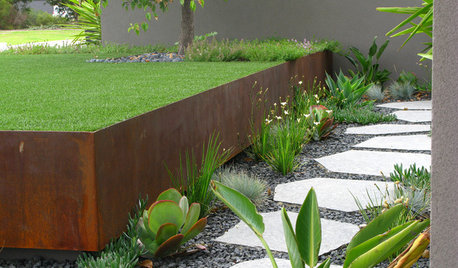
LANDSCAPE DESIGN7 Questions to Ask Before Laying Stepping Stones
These broken-up pathways invite you to put a spring in your step — while adding functionality to the garden
Full Story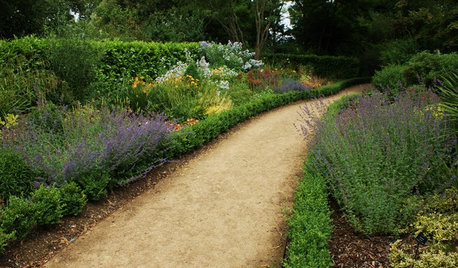
LANDSCAPE DESIGN5 Gravel and Stone Types for a Rockin' Landscape
Give your garden design some textural bam with pebbles, granite, river rocks and other permeable materials
Full Story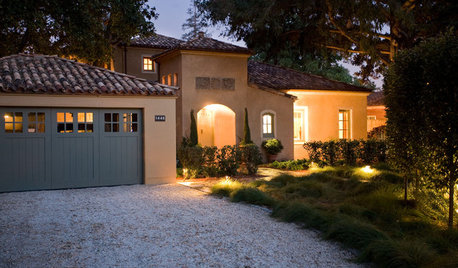
REMODELING GUIDESGravel Driveways: Crunching the Pros and Cons
If you want to play rough with your driveway, put away the pavers and choose the rocky road
Full Story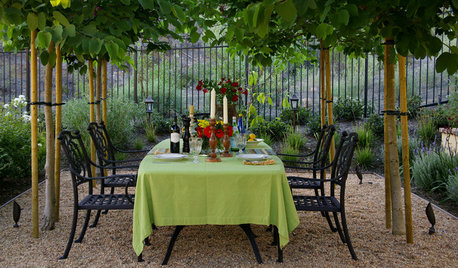
LANDSCAPE DESIGNEnjoy the Romance of Dining in a Classic Gravel Garden
Here’s what to consider when it comes to installing, styling and maintaining a DIY-friendly gravel patio
Full Story
GREEN BUILDINGConsidering Concrete Floors? 3 Green-Minded Questions to Ask
Learn what’s in your concrete and about sustainability to make a healthy choice for your home and the earth
Full Story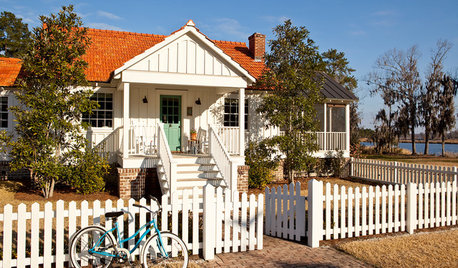
REMODELING GUIDESConsidering a Fixer-Upper? 15 Questions to Ask First
Learn about the hidden costs and treasures of older homes to avoid budget surprises and accidentally tossing valuable features
Full Story
CURB APPEAL7 Questions to Help You Pick the Right Front-Yard Fence
Get over the hurdle of choosing a fence design by considering your needs, your home’s architecture and more
Full Story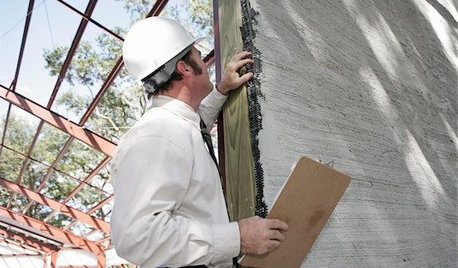
MOVINGHiring a Home Inspector? Ask These 10 Questions
How to make sure the pro who performs your home inspection is properly qualified and insured, so you can protect your big investment
Full Story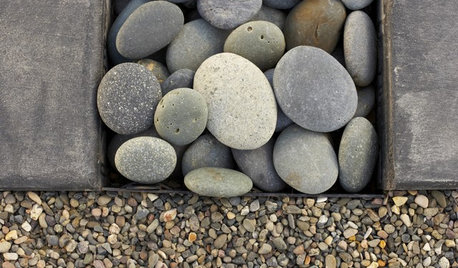
LANDSCAPE DESIGNThe Right Stone for Your Garden Design
Gravel, pebble, cobble and paddle: Stones vary in size and shape, and have different uses in the landscape
Full Story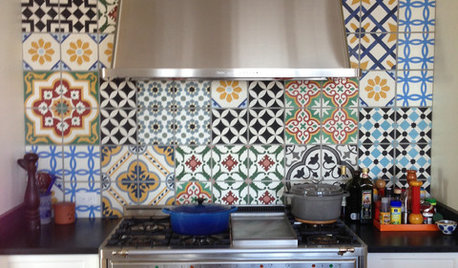
TILESo Many Reasons to Love Cement Tiles
You’ll notice their beautiful patterns right away, but cement tiles have less obvious advantages too
Full Story






marcinde